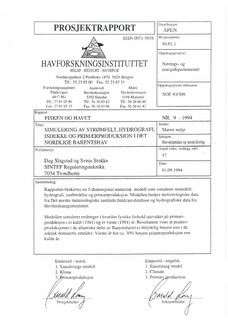| dc.description.abstract | This report describes a numerical 3-dimensional model that simulates, current field, ice distribution,
hydrography and primary production. The model uses input data from norwegian
meteorological stations and data from the Det norske meteorologiske institutts (MI) hindcastdatabase.
From initialfields of temperature and salinity, change in the hydrography as a result
transport, fresh water supply from land, cooling/heating and melting/freezing of ice is simulated.
A warm year (1984) and a cold year (1981) are selected in order to study how the climate
may affect primary produciion. The model simulates, according to the observed values, a large,
southern ice distribution in 1981 and much less in the warm year which form a basis for simulations
of the primary production. The annual production of phytoplankton is in particular
dependant on the ice distribution during the spring. When the ice melts, strong vertical stabiliiy
is created which reduces the vertical transport of nutrients compared with conditions where termal
heating alone creates stability. The lager the ice cover is, the lager area would obtain
strong stability after the ice melts. When comparing the cold and the warm year simulated here,
the primary production is between 25 and 250% higher i the area which were free of ice in 1984,
but ice covered in 1984. The total annual production for the whole Barents Sea increased about
30% from 1981 to 1984.NORSK SAMMENDRAG:Rapporten beskriver en numerisk 3-dimensjonal modell som simulerer, strømfelt, hydrograi,
isutbredelse og primærproduksjon. Modellen bruker inngangsdata fra norske meteorologiske
stasjoner og data fra Det norske meteorologiske institutts (MI) hindcast-daiabase. Ut fra et startfelt
for hydrografi simuleres endringer i hydrografien som et resultat av transport, avrenning fra
land, avkjøling og smelting/frysing av is. Det er valgt ut to år, et kaldt (1981) og et varmt (1984)
som studeres med hensyn på klimatisk påvirkning av primærpmduksjonen. Modellen simulerer
i overensstemmelse med observerte verdier mye is i 1981 og tilsvarende lite i det varme året slik
at dette gir et grunnlag for videre simulering av primærproduksjon.Å rsproduksjonen av planteplankton
er spesielt avhengig av isutbredelsen om våren. Når isen smelter, blir det høy vertikal
stabilitet noe som reduserer vertikal transport av næringssalter sammenlignet med områder hvor
det er termisk oppvarming som skaper stabilitet. Jo større deler av Barentshavet som er dekket
av is, jo strre områder vil ha høy sttabilitet når isen har smeltet. Sammenligner vi det kalde og
det varme året som er simulert her, viser det seg at primærpmduksjonen er mellom 25 og 250%
høyere i det området som var isfritt i 1984, men isdekt i 1981. Totalt steg primærproduksjonen
i Barentshavet med rundt 30% fra 198 1 til 1984. | en |
